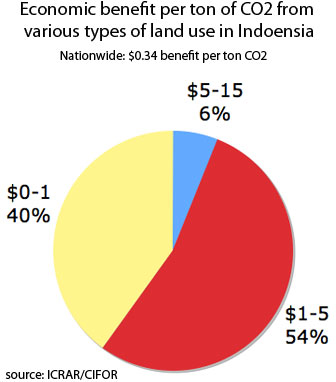?
Carbon offset returns beat forest conversion for agriculture in Indonesia
Carbon offset returns beat forest conversion for agriculture in Indonesia
Rhett A. Butler, mongabay.com
November 21, 2007
Conversion of forests and peatlands for agriculture in Indonesia has generated little economic benefit while releasing substantial amounts of greenhouse gases into the atmosphere, reports a new study from the the World Agroforestry Centre (ICRAF), the Center for International Forestry Research (CIFOR) and their Indonesian partners.
The study, which looked at carbon emissions and land use changes in three Indonesian provinces covering 16 percent of the country, calculated the economic benefits derived from different types of land use, including oil palm, rubber, coffee and mixed agroforestry.
“Combined, these provinces emit 400 mega-tons of carbon dioxide (CO2) per year from the conversion of forests and peatlands,” said Dr Meine van Noordwijk, Regional Coordinator for the World Agroforestry Centre (ICRAF). “We found that less than two percent of these emissions resulted in clear economic benefits generating more than US$15 per ton of CO2 emitted.”

|
The researchers found that six percent of the emissions generated benefits between US$5 and US$15 per ton of CO2, slightly over half of emissions generated between $1 and $5 of benefits, and about 40 percent between 0 and $1 per ton of CO2. Overall, Indonesia is seeing benefits of 0.23 Euro ($0.34) per ton of CO2 For comparison, the Stern report–a U.K. government-backed report on climate change–estimated the present value of the damages from emitting one ton
of carbon dioxide at $85, while carbon credits in European markets are currently trading at more than $34 per ton of CO2.
The discrepancy suggests “there is a very real opportunity for the country to benefit from a carbon market which compensates for Reducing Emissions from
Deforestation and Degradation (REDD),” states the report, which goes on to say that international mechanisms must look at all types of land uses–not just forests–for their potential to reduce emissions.
“We need to continue collecting data on carbon stocks and the economic benefits of different land uses so that Indonesia can explore ways to reduce its CO2 emissions without affecting the countries economy,” said Dr Daniel Murdiyarso, Senior Scientist with the Centre for International Forestry Research (CIFOR). “This data will also help us to benefit from an emerging carbon market as investors will need evidence of success in emission reductions before any money changes hands.”
“While additional funding through an international carbon market can provide incentives, Indonesia must make a real commitment to emission reduction,” he added.
Scientists are hopeful that REDD could not only help offset emissions, but safeguard biodiversity and other important ecosystem services. However development agencies say that more details need to be fleshed out to ensure that REDD delivers economic benefits to populations that are most in need
“REDD as currently discussed will only address part of the issue and it is not yet clear how incentives will reach people on the ground who need to benefit from changing land uses,” noted van Noordwijk.
RELATED
Oil palm does not store more carbon than forests
(11/08/2007) Officials from the Indonesian ministry of agriculture and the palm oil industry are distributing materials that misrepresent the carbon balance oil palm plantations, according to accounts from people who have seen presentations by members of the Indonesian Palm Oil Commission. Ministry of agricultural officials are apparently arguing that oil palm plantations store and sequester many times the amount of CO2 as natural forests and therefore converting forests for plantations is the best way to fight climate change. In making such claims, these Indonesian officials are ignoring data that show the opposite, putting the credibility of the oil palm industry at risk, and undermining efforts to slow deforestation and reign in greenhouse gas emissions.
Greenwashing the palm oil industry
(11/12/2007) A new report from Greenpeace alleges that members of the Roundtable on Sustainable Palm Oil — an industry-driven initiative to clean up palm oil production — are using palm oil derived by clearing endangered rainforests and draining carbon-rich peatlands on the Indonesian island of Sumatra. Tracing palm oil back to its source plantations in Riau, the report found that Nestle, Procter & Gamble, and Unilever – are sourcing their palm oil from suppliers who are responsible for forest destruction. Palm oil is used in products as diverse as candy bars, cosmetics, and biodiesel..















